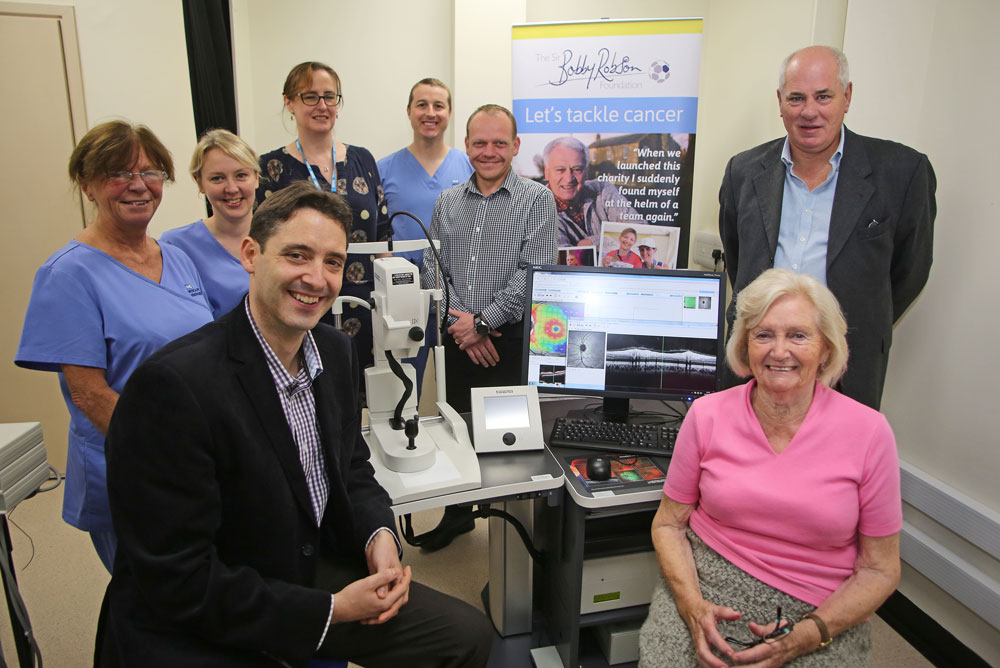 Hemel Hemstead, UK – Heidelberg Engineering’s SPECTRALIS OCT has been given a leading role in a new cancer care unit for the north-east, funded by the late Sir Bobby Robson’s Foundation.
Hemel Hemstead, UK – Heidelberg Engineering’s SPECTRALIS OCT has been given a leading role in a new cancer care unit for the north-east, funded by the late Sir Bobby Robson’s Foundation.
The former England Football Manager, and star player, left a legacy which is helping to fund care within the Ophthalmology Clinical Trial Evaluation Suite at Newcastle’s Royal Victoria Infirmary. It is playing a crucial role in assessing the eye health of patients undergoing trials of cancer drugs at the Sir Bobby Robson Cancer Trials Research Centre, with results expected to benefit patients internationally.
The SPECTRALIS and a visual field analyser are being used by Consultant Medical Ophthalmologist, Dr Will Innes, and his team to monitor patients being treated with innovative small molecule anti-cancer drugs, designed to disrupt very specific cancer cells.
Dr Innes explained:
“Professor Plummer’s* team at the Sir Bobby Robson Centre is working with a new generation of cancer drugs which are incredibly powerful and a significant step forward in treatment. With these drugs, the eye is ‘an organ at risk’ because some of the proteins and receptors that are targeted in cancer cells are also present in the eye. It is essential that we closely monitor eye health during treatment and, with this equipment, we can do that.”
“Before we had this dedicated evaluation suite patients had to visit separate areas of the hospital to have their eyes assessed, in some cases, on a weekly basis. For anyone who is unwell, and especially for patients who are struggling to breathe because of cancer, it was very difficult to complete the eye checks necessary.”
The SPECTRALIS generates extremely high resolution images of the inside of the eye using coloured lasers that scan the retina up to 60,000 times per second. This creates ‘image slices,’ which are stacked to form 3D images of the retina and provide detailed maps of individual retinal layers.
Dr Innes added:
“We have the same OCT system that is on board the International Space Station, monitoring the vision of astronauts, which gives you an idea of how advanced this equipment is.”
A separate system, which was already in place at the RVI, records electrical signals from the eye, optic nerve and brain in response to visual stimuli. Responses are altered in a variety of ways by disease processes and drug toxicity, which affect the retina, optic nerve and higher visual pathways.
All this information, along with the visual field analysis, produces what Dr Innes describes as an “exquisitely detailed” picture of the eye’s structure and function, allowing oncologists to react very quickly to changes. This surveillance enables patients to continue with therapy that, without appropriate monitoring, might be risky.
“Oncologists are traditionally trained to deal with treatment side effects, such as hair loss, mouth and bowel problems and the dropping of white blood cell counts. With these new treatments ophthalmology is now also an essential element of monitoring.”
Sir Bobby’s widow, Lady Elsie and son, Andrew Robson, plus Widnes Viking Director Brian O’Connor (pictured) were fascinated to see the detail produced by the new eye evaluation technology.
“This marvellous new equipment will help push forward new drug trials and also make things easier for cancer patients. We’re very proud to have been able to fund it,” said Lady Elsie.
Sir Bobby Robson launched his Foundation in 2008 and it has gone on to raise over £11 million to find more effective ways to detect and treat cancer. Working within the NHS, and in collaboration with Newcastle University, it relies completely on volunteer fundraisers and public generosity.
*Professor Ruth Plummer, Director of the Sir Bobby Robson Cancer Research Trials Centre, was Sir Bobby’s oncologist, is a Trustee of the Foundation and Lead of the Cancer Research UK Centre at the Northern Institute for Cancer Research in Newcastle.
Over 600 new patients were enrolled on clinical trials at the centre in the last year alone and there has been a year on year increase in the number of clinical trials open to recruitment. Staffing in the centre has risen from 27 when it opened to 51 and further developments are planned.


